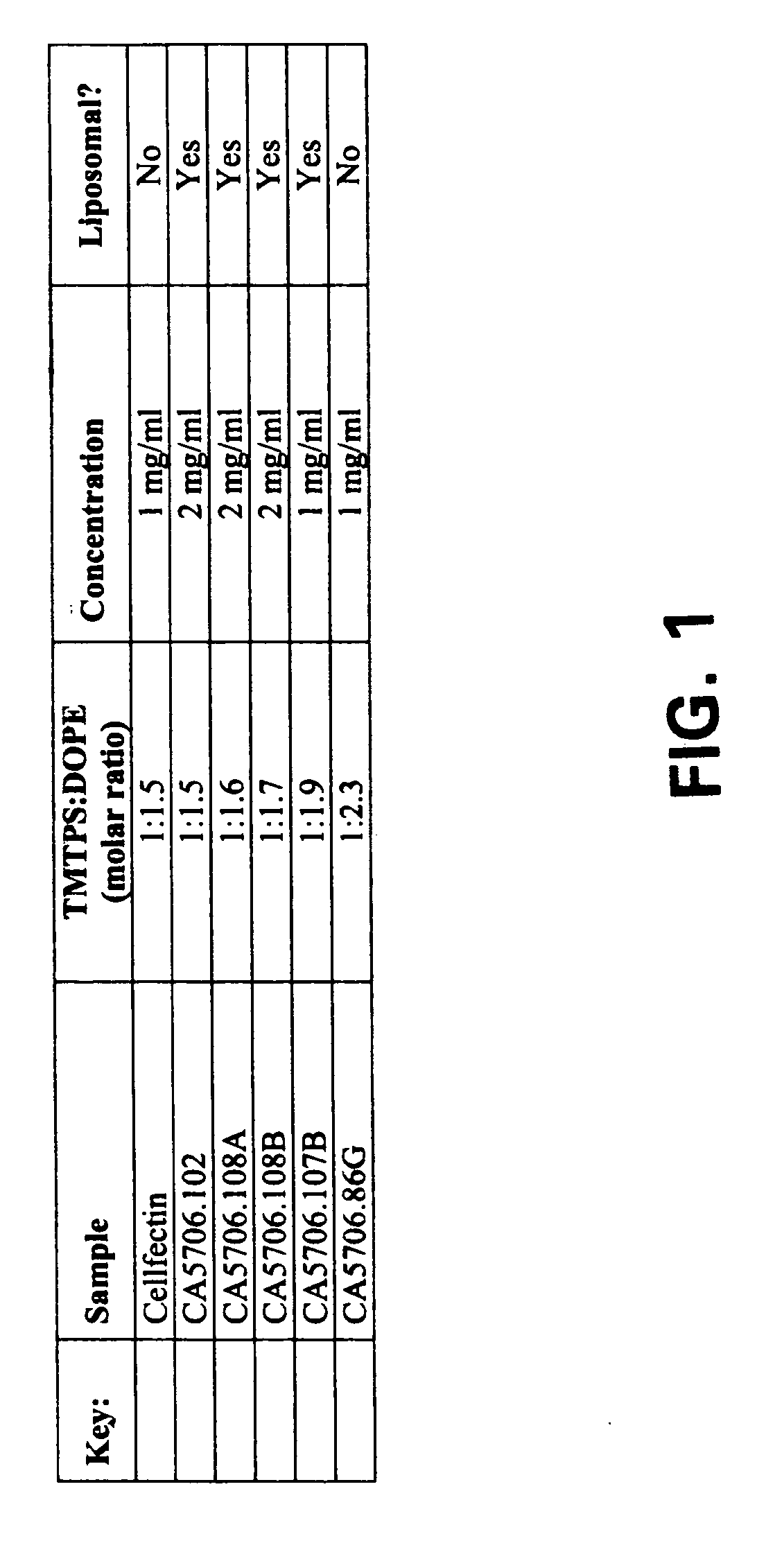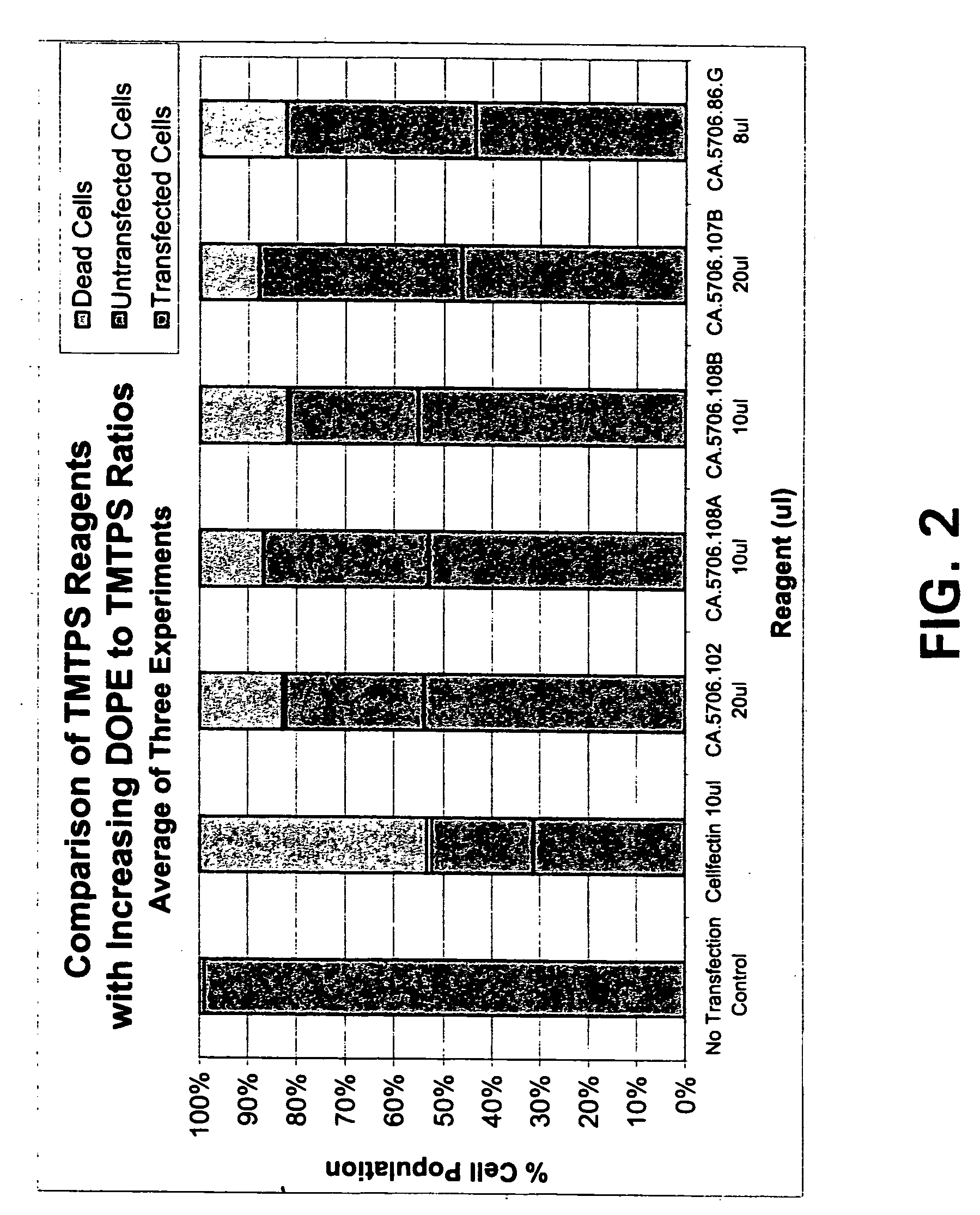Transfection reagent for non-adherent suspension cells
a technology of suspension cells and transfection reagents, which is applied in the direction of microencapsulation, pharmaceutical delivery mechanisms, and material to be delivered must be encapsulated, etc., can solve the problems of toxic to cells adapted to non-adherent growth, insufficient effectiveness of current transfection reagents for non-adherent growth, and insufficient efficacy of non-adherent growth, etc., to achieve less toxicity, high transfection efficiency, and high transfection efficiency
- Summary
- Abstract
- Description
- Claims
- Application Information
AI Technical Summary
Benefits of technology
Problems solved by technology
Method used
Image
Examples
example 1
[0153] In one embodiment of the invention, the transfection reagent comprises N, N′,N″, N′″ tetramethyltetrapalmitylspermine (TMTPS-Iodide). To prepare TMTPS-Iodide, 3.88 g of spermine (Sigma Cat. #S 3256) is first added to a 3 liter round bottom flask. 2000 ml of chloroform is added to the flask, followed by 8.6 ml of triethylamine (Aldrich Cat. #13,206-3). A rubber septum is attached to the flask opening and an argon balloon attached to the septum. The flask is set in an ice bath and cooled for 30 minutes. Palmitoyl chloride, 19.2 ml (4.2 molar equivalent) Aldrich Cat. #P7-8, was slowly added to the flask with a syringe. As an alternative, an increased amount of palmitoyl chloride 27.7 ml (4.8 molar equivalent) can be added.
[0154] The flask is removed from the ice bath, and the reaction allowed to proceed for 48-72 hours at room temperature with stirring. The reaction is analyzed using THF(1):CH2Cl2(2). The flask is set in an ice bath and cooled for approximately 30 minutes. The ...
example 2
[0158] 1.1163 g TMTPS-Iodide (from example 1) and 0.8846 g of DOPE are added to a two liter round bottom flask. Approximately 100 ml of methylene chloride is added and the contents of the flask are swirled or shaken until all of the lipid dissolves. The methylene chloride is evaporated on a rotary evaporator for approximately 10 minutes and the flask is attached to a high vacuum pump overnight to form a lipid film on the inner surface of the flask.
Formation of Liposome Protocol
example 3
[0159] 1,000 ml of distilled water is added to the flask having the lipid film from example 2. This will achieve a concentration of 2.0 mg / ml. The contents of the flask are swirled or shaken until all of the lipid is dislodged from the surface of the flask. The lipid suspension is passed through a microfluidizer (Models 110Y and 110T, Microfluidics Corp., Newton, Mass.) at a flow rate of 330±10 ml / min at approximately 60 psi. The lipid suspension is collected in an autoclaved 2 liter Erlenmeyer flask and passed through the microfluidizer four more times (for a total of 5 passes). After the final pass, the lipid suspension is collected in an autoclaved 2 liter Erlenmeyer flask.
[0160] The concentration of the liposome formulation is checked by thermogravimetric analysis (using a Perkin Elmer, model TGA7 instrument) and the concentration is adjusted to 2.0 mg / ml with distilled water. The particle size of the liposome formulation is checked using a particle analyzer (dynamic light scat...
PUM
| Property | Measurement | Unit |
|---|---|---|
| particle size | aaaaa | aaaaa |
| particle size | aaaaa | aaaaa |
| diameter | aaaaa | aaaaa |
Abstract
Description
Claims
Application Information
 Login to View More
Login to View More - R&D
- Intellectual Property
- Life Sciences
- Materials
- Tech Scout
- Unparalleled Data Quality
- Higher Quality Content
- 60% Fewer Hallucinations
Browse by: Latest US Patents, China's latest patents, Technical Efficacy Thesaurus, Application Domain, Technology Topic, Popular Technical Reports.
© 2025 PatSnap. All rights reserved.Legal|Privacy policy|Modern Slavery Act Transparency Statement|Sitemap|About US| Contact US: help@patsnap.com



